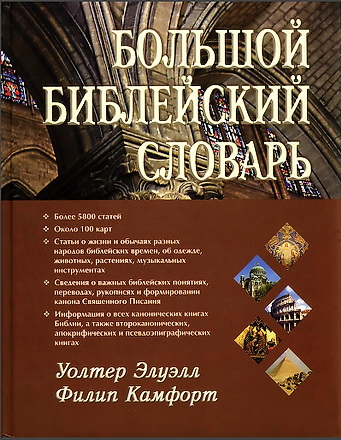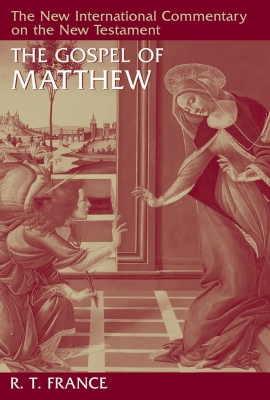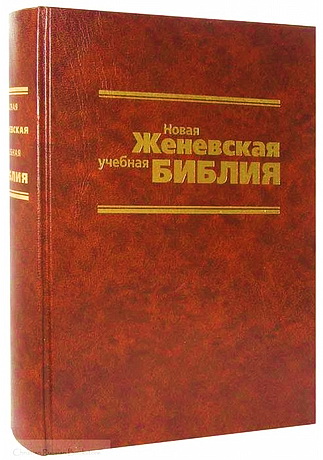
France - The Gospel of Matthew – NICNT - модуль BibleQuote
France R. T. - The Gospel of Matthew – The New International Commentary on the New Testament (NICNT)
Grand Rapids, MI: Wm. B. Eerdmans Publishing Co., 2007. – 1233 p.
ISBN-13: 978-0802825018
This is designed to be an exegetical commentary. Its primary aim is to provide information and comment which will help the reader of the Gospel of Matthew to understand and appreciate that text. If in the process I can share something of my own deep appreciation of the insight and skill of its author, as well as of the importance and fascination of its subject matter, I shall be pleased.
It has been one of my major concerns to locate the individual parts of the gospel within the overall narrative flow of the whole—to look at the woods before focusing in on the trees. In the Introduction (pp. 2-5) I have set out my understanding of the structure of the gospel, which has determined the sections into which I have divided it for the purpose of commenting on it. Each section, large and small, is discussed as a whole before turning to the individual pericopae (a convenient scholarly term for “units” or paragraphs perceived in the text) into which I have subdivided it. It should be emphasized that these subdivisions, and indeed the overall structure I have discerned in the narrative, represent my own reading of the text, and do not claim to follow a pattern disclosed by the author. I am too well aware of the differences of opinion on even the most basic structural issues to assume that any such “author’s design” is there to be read off from the surface of the text. Quite often I shall draw attention to competing views of the appropriate way of subdividing the text and explain my own decision. But it remains just that, my decision, representing only how one sympathetic reader has responded to the dynamics of the text.
Each of the pericopae into which I have divided the text is also discussed as a whole before any attempt is made to comment on the individual verses or groups of verses within it. This will often mean that the most fundamental issues for the meaning of the text will not emerge in my comments on a specific verse, as the long tradition of verse-by-verse commentary has conditioned many of us to expect. I have therefore dared to presume that the reader, even if seeking guidance on a particular phrase or sentence, will be prepared to read the comments on the pericope as a whole.
This last point applies also to the English translation of the text, which I have given at the beginning of each pericope. The translations are my own, and the footnotes to them often explain my renderings of specific words and phrases, which will then be presupposed in the commentary. The translations are designed to provide the basis for the commentary rather than for use on their own. They attempt to use contemporary idiom, and, where necessary, give priority to clarity over literary elegance. The notes to these translations also draw attention to some textual variations which are likely to be of exegetical interest; for this purpose I have generally been guided by the selection of variants made by the editors of The Greek New Testament (4th edn., Deutsche Bibelgesellschaft / United Bible Societies, 1998), though I have not always agreed with their textual judgment.
* * *
IV. JERUSALEM: THE MESSIAH IN CONFRONTATION WITH THE RELIGIOUS AUTHORITIES (21:1-25:46)
Here, for the first time in the Synoptic accounts2320 (except for a childhood visit in Luke 2:41-52), Jesus and his disciples come to the Jewish capital, the site of the temple which was the earthly focus of the religion of Israel. The visit will be brief. All the narrative of 21:1 to 28:15 appears to cover a period of only about one week, focused on the Passover festival which takes place as its climax and in the context of which Jesus will be executed. During this week the events which Jesus has so starkly predicted in 16:21; 17:22-23; and 20:17-19 will at last take place, and the fulfillment of those predictions will be carefully documented in these chapters. The shadow of those events has fallen across the whole of the journey narrative in chs. 16-20, and now with the arrival of Jesus and his Galilean followers outside the city walls we see the beginning of the decisive confrontation with the Judean authorities for which we have been well prepared.
I have divided this climactic part of Matthew’s narrative into two major sections (21:1-25:46 and 26:1-28:15), even though in my commentary on Mark I treated the whole Jerusalem narrative together as a single final “act” of a deliberately three-act drama. Two distinctive features of Matthew’s story have persuaded me to divide this section despite the fact that it contains no change in geographical location. First is the fact that a three-act structure is in any case ruled out by Matthew’s inclusion of a further “act” in the contrasting location of Galilee as the conclusion to his story in 28:16-20; for him Jerusalem is not the end. Even if Mark originally planned (or indeed wrote) such a final Galilean scene,2321 it is not part of his gospel as we know it, and this difference in Matthew’s narrative scheme must be honored. But secondly, and more significantly, Matthew’s account of the period in Jerusalem before the last supper is considerably longer than the equivalent section in Mark 11:1-13:37. In his account of Jesus’ confrontation with the authorities in the temple Matthew has included two additional parables and the whole of ch. 23 with its diatribe against the scribes and Pharisees, while the discourse of Mark 13 has increased in Matthew to more than twice its Marcan length by the addition of a substantial section of parables and other teaching about the messianic future. The result is that chs. 21-25 provide a much more extended and theologically weighted account of the confrontation which precedes the passion narrative proper, in which Matthew has filled out his distinctive theology of the royal authority of the Son of Man in contrast to the failure of the existing regime and the temple on which its authority is centered. These five chapters are much more than simply an introduction to the passion narrative; they challenge the reader to think through, before the final dénouement of the story, who is now the true Israel.2322
This whole section divides naturally into two parts: in chs. 21-23 Jesus confronts and debates with the Jerusalem authorities, while in chs. 24-25 he talks privately to his disciples about what is to come and what it all means in relation to the fulfillment of the OT vision of the kingdom of the Son of Man. The transition between these two parts is clearly marked by Jesus’ leaving the temple (24:1). The repudiation of the misguided religion of the scribes and Pharisees leads up to a climax in 23:29-39 with the pronouncement that judgment is now to fall on “this generation” and in particular that “your house” is to be abandoned. The more explicit prediction to the disciples that the temple will be totally destroyed (24:2) then provokes a bewildered question as to how this prediction fits in with “your parousia and the close of the age,” and it is this question which Jesus will deal with in the last great discourse of the gospel, which deals first with the coming destruction of the temple and secondly with the subsequent parousia and final judgment by the Son of Man.
But while in chs. 24-25 the audience has changed, the essential thrust of the narrative has not. Ever since Jesus has ridden up to the city as the “Son of David,” the focus has fallen on the question of his authority. His openly messianic gestures have led inevitably to a confrontation between the self-proclaimed Galilean “king” and the Jerusalem authorities whose position he threatens. In the debates and polemic which follow, the reader is faced with a fundamental choice between the old, discredited leadership and the Son of Man who has come to fulfill his messianic mission. The three polemical parables of 21:28-22:14 all focus on the contrast between the true and the false, those who fulfill their responsibilities and those who do not; in all of them there is a surprise in store for those who were confident of their own position of privilege, a reversal of fortunes by which the first become last. After this the prediction of the destruction of the temple and the discourse which explains it do not change the subject. This temple is the visible symbol of the old regime; its fall is not just the loss of a building but the end of an era. The kingdom of the Son of Man will be established in its place, and the great discourse will reach its superb climax in the vision of the Son of Man ultimately enthroned in power and pronouncing judgment over all the nations.
It is against that perspective that Matthew’s reader is then able to read the story of Jesus’ rejection, condemnation, and death, and to perceive that the “defeat” of Jesus by his enemies is in fact the paradoxical way to the establishment of his kingship. Even on the cross he is king, and when death is itself defeated in the resurrection the reader will be able to recognize in Israel’s rejected Messiah the one to whom “all authority in heaven and on earth has been given” (28:18).
I have spoken above generally of “the Judean authorities” or “the Jerusalem leadership.” Matthew in fact uses a variety of more specific titles for the people with whom Jesus is in confrontation in chs. 21-23. We meet “the chief priests and the scribes” (21:15), “the chief priests and the elders of the people” (21:23), “the chief priests and the Pharisees” (21:45), “the Pharisees . . . with the Herodians” (22:15-16), “Sadducees” (22:23), and “the Pharisees” (22:34, 41), until in ch. 23 the focus finally narrows down specifically to “the scribes and Pharisees” who are the repeated target of Jesus’ polemic in that chapter. It seems that Matthew wants us to recognize a wide “coalition” of different groups, who on other matters would not see eye to eye, coming together to oppose this northern preacher who in different ways threatened each of their positions of power and influence. When the actual process of the arrest and trial of Jesus begins in ch. 26, it will be predominantly the chief priests and elders who are mentioned as Jesus’ opponents (see below on v. 23), but for now the base of opposition is much more widely drawn.2323
The account of the public confrontation in chs. 21-23 follows a natural progression from the initial provocative arrival and gestures of Jesus to the authorities’ challenge to his authority and on through a sequence of public encounters and challenges as Jesus teaches in the temple courtyard to the point where in ch. 23 dialogue becomes monologue and Jesus denounces the scribes and Pharisees without response. Within this overall development Matthew’s distinctive style may be discerned in the way many of the episodes fall into groups of three: three symbolic actions (21:1-22), three polemical parables (21:28-22:14), and three hostile questions and responses (22:15-40).
A. THE CONFRONTATION BEGINS: THREE SYMBOLIC ACTIONS (21:1-27)
Jesus’ arrival in Jerusalem is deliberately dramatic. It begins with two actions designed to draw attention and to provoke people to think about Jesus’ messianic claim (the royal procession to the city walls and the attack on the traders in the temple courtyard), together with a further symbolic action (the miraculous destruction of the fruitless fig tree) which, though witnessed only by Jesus’ immediate entourage, seems to be closely connected with his prophetic action in the temple.2324 In the first of these actions Jesus is supported and acclaimed by the pilgrim crowd who accompany him to Jerusalem, but in the second he apparently acts alone. In both cases, however, Matthew tells us of the hostile reaction of Jerusalem, in the first case in the response of “the whole city” (v. 10) and in the second as focused on the leading group of “chief priests and scribes” (v. 15). Jesus has publicly thrown down the gauntlet, and so this section concludes with the response of the “chief priests and elders of the people,” representing the Sanhedrin, who publicly question Jesus’ right to act in this high-handed way. That this challenge takes place in the temple courtyard where Jesus’ most provocative action has been staged sets the scene for the continuing confrontation which will all be set in the same temple area until Jesus finally and decisively leaves the temple in 24:1.
Three aspects of the historical situation are important for understanding the significance of these and the following incidents in Jerusalem.
(1) The “temple.” I have spoken of “the temple courtyard” (where Matthew speaks simply of “the temple”) to make it clear that the location for these scenes is not the temple building itself, the place of sacrifice (into which only priests were allowed to go), but the much more extensive area surrounding the temple building, which we refer to as the Court of the Gentiles. The majority of the huge temple complex (about 13.5 hectares, thirty-three acres, roughly six times the size of Trafalgar Square) consisted of this open space, nearly a mile in circumference, surrounding the temple building and its inner courtyards and itself surrounded by porticoes, into which anyone could go so long as they did not pass the barriers which restricted the central area to Jews. It formed the natural meeting place for visitors and locals alike, especially at festival seasons, and the porticoes provided shaded areas for groups to gather and for teachers to collect a crowd, and in the days before the Passover also for the flourishing market in sacrificial animals and sacred money (see below). When Jesus “taught in the tem-ple,” he may well have been one of several such teachers, but he was in the place where people in general could best be reached.
(2) Passover. Of the three pilgrimage festivals when all adult male Jews were in theory expected to visit the temple in Jerusalem (Passover,2325 Weeks [Pentecost], and Tabernacles; Deut 16:16) Passover seems to have been the most enthusiastically observed. Passover pilgrims came not only from Galilee and other Palestinian provinces, but from all over the Mediterranean world where Jews were settled. The nearest modern equivalent is perhaps the Hajj to Mecca. Ancient and modern estimates of the numbers involved vary wildly, but the calculation of J. Jeremias2326 perhaps offers a reasonable approximation: he estimates the normal population of Jerusalem at the time as about thirty thousand, but the number present at Passover as something like 180,000. There were therefore many times more people than the city could properly accommodate, and Passover groups camped all around the city (see on 21:17). The official city limits were extended at Passover time to include the surrounding hillsides, Bethphage (v. 1) being the outer limit according to the Talmud. The temple courtyard would be the natural gathering ground for this huge throng of people during the festival.
(3) Galileans. See pp. 5-7 for the differences between Galilee and Judea and their importance for Matthew. A Galilean was essentially a foreigner in Jerusalem, and Jesus’ entourage, being made up of Galileans, would normally stand out as distinctive among the Jerusalem crowd. At Passover time the cosmopolitan crowd would make this less obvious, and of course many other Galileans would be present. We have already noted (see on 20:29) that the “large crowd” which accompanied Jesus to the city were probably mainly Galileans, and no doubt others were already there or arrived during the week. We shall note below in vv. 10-11 the impact of this Galilean influx on the city. But Jesus’ recorded dealings are not with the larger Passover crowd but with the Jerusalem authorities, and to them the challenge of the prophet from Nazareth and his Galilean movement (v. 11) represented an unwelcome threat. The comment on Peter’s Galilean accent in 26:73 reveals something of the cultural background to this confrontation.





Комментарии
Пока нет комментариев. Будьте первым!